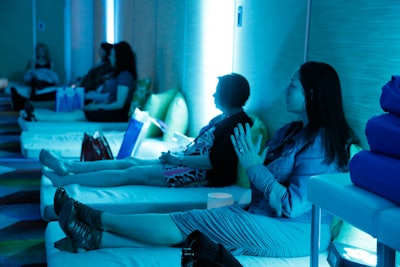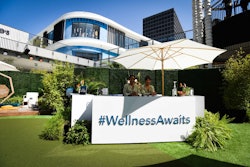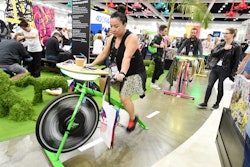
Wellness is a growing trend in the workplace, as more companies are responding to their employees’ desire to incorporate physical and mental fitness activities into their day. According to the Gallup-Healthways Well-Being Index, nearly six in 10 millennials say that work-life balance and well-being in a job are “very important” to them. That concept is also impacting the meetings and events industry. Whereas a few years ago, wellness at a conference may have meant adding a 5k run on the agenda one morning, now planners are creating destinations within their events that offer yoga, meditation, nutrition tips, and other self-help opportunities.
“With any kind of meeting or event, it’s a very high intensity arena," says Lee Papa, a mindfulness trainer and speaker. "There’s education, there’s networking, there’s a limited amount of time. Usually there’s travel involved so there may be jet lag. So it’s the perfect storm for stress."
BizBash asked Papa and Dr. Kim Bercovitz (also known as Dr. Kim), the founder of X Bytes wellness company, for their tips on how planners can create an effective environment for attendees to re-charge.
1. Location
At some events, the wellness lounge may be right at the entrance to or in the middle of a trade show floor, while at others it is located in a breakout room removed from the main activity. There are pros and cons to both options. Putting it in a visible location will draw more traffic from people passing by, but it may also be loud and less conducive to mindfulness.
“If the lounge is at the end of a corridor or in a separate classroom, I’ve found we may only get as few as one to three people,” Bercovitz says. That’s why she prefers a busier environment and mitigates noise by having guests wear wireless headsets. “They not only block the noise but also create a private, intimate experience when it comes time for yoga or mindfulness or even learning,” she says.
Papa says the size of the event should influence the location. “You don’t want it so far away at a large event that people have to walk a long distance if they are trying to stop in between sessions,” she says. “And the most optimal space is quiet, but it doesn’t have to be completely without sound. My goal is to help people understand how to meditate even in the middle of a busy space like an airport.”
2. Atmosphere
Consider how the space will feel to your attendees by addressing the senses of sight, sound, and smell. “The design is very important because it needs to have a calm feel,” Papa says. “I use things like essential oils and the sound of running water. I can’t tell you how many people will walk by one of these lounges and they may not know what it is but they think ‘Oh, it smells really good,’ so they come in.”
3. Seating
The activities you are offering determine the type of seating you will need. If there will be a trainer offering tips and leading a discussion, you may want tables, chairs, and flip charts. If you are offering more introspective activities such as meditation, consider setting out a mix of chairs and large mats and pillows for guests who want to relax a bit more.
4. Scheduling
Papa suggests offering the first session before any of the meetings or sessions begin, to help attendees start their day with more clarity and energy. Then schedule a variety of opportunities throughout each day. “Put wellness sessions between other sessions and make them bite-size, about 15 minutes, so people can stop in during part of a break,” Bercovitz says.
5. Sponsorship
Since wellness lounges usually are still considered a “nice to have” rather than a “have to have” element of an event, try to find sponsors to help cover costs, for example by providing drinks and snacks for guests. Ideally the sponsor is a company that is in sync with the concept of wellness, such as one that makes fitness supplies or nutritious food. “When I talk about being careful about the energy of the room, it can very quickly not be what it’s designed to be if it’s overly sponsored, or if the sponsor is not in alignment with mindfulness and understanding the important of the quiet space,” Papa says.
6. Takeaways
Bercovitz suggests creating a short tip sheet of some of the topics covered in the experience, for example meditation tips or ideas for healthy snacks. And if there is funding in the budget or from sponsors, consider sending guests away with a “road warrior kit” that can include items such as a jump rope, resistance bands, and snacks.



















